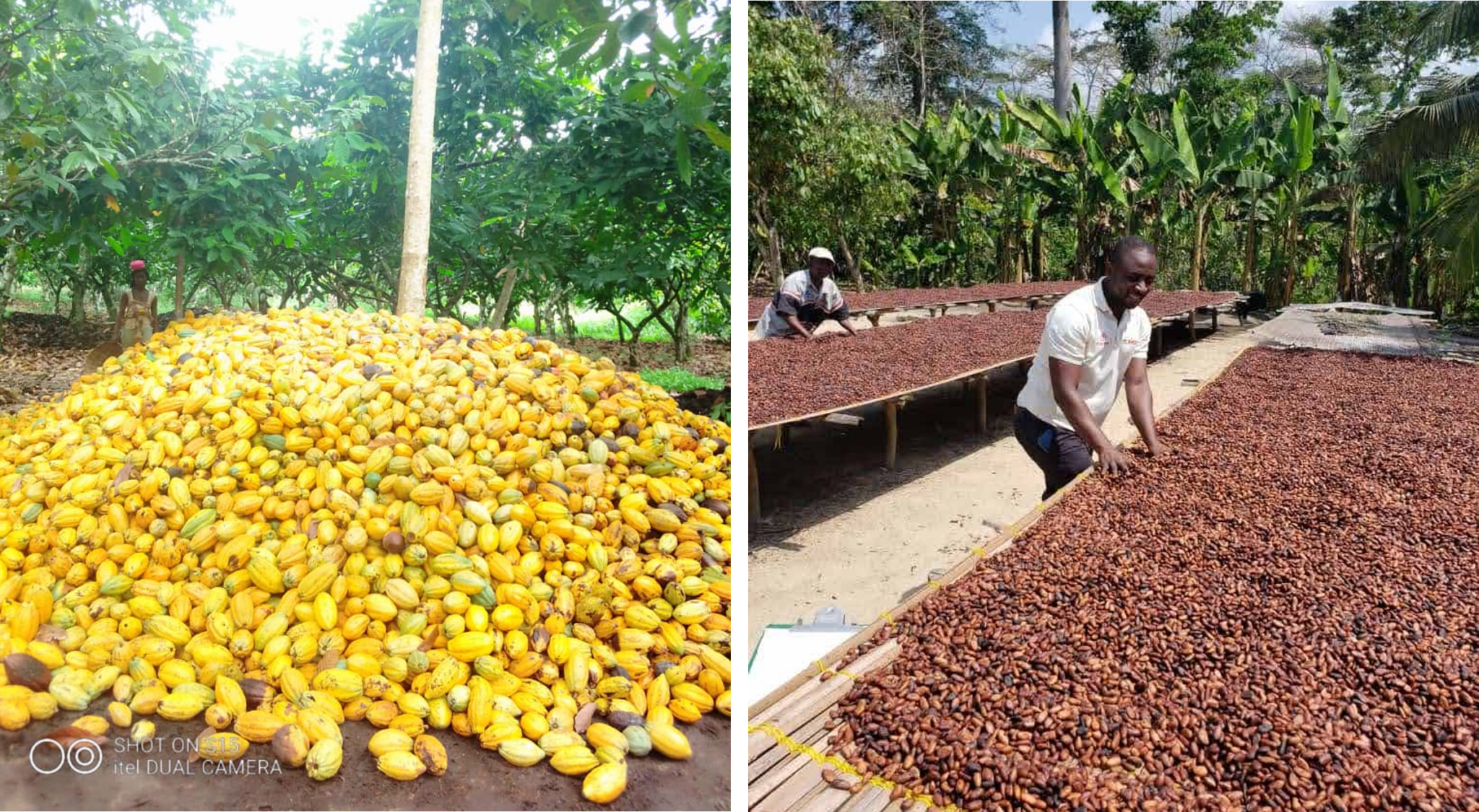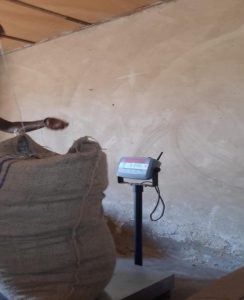可可的收获、处理和储存

这篇文章也可以在:
这篇文章也可以在:
![]() English (英语)
English (英语) ![]() Español (西班牙语)
Español (西班牙语) ![]() Français (法语)
Français (法语) ![]() Deutsch (德语)
Deutsch (德语) ![]() العربية (阿拉伯语)
العربية (阿拉伯语) ![]() Português (葡萄牙语(巴西))
Português (葡萄牙语(巴西))
大多数可可树在第4年或第5年可以开始生产豆荚,并且如果护理得当,它还可以继续生长30年。根据不同的品种,每棵可可树可以生产大约30个豆荚。一个正常的豆荚中有20到50个豆子,而生产一磅可可需要400颗干可可豆。
对于大多数种类的可可荚来说,当它们变成深黄色时就可以收获了。农民们通常会使用砍刀和长柄的刀等钢制工具从树上砍下豆荚,并用实心棒和砍刀将豆荚分开,从而取出种子。对于大多数农民小规模种植可可,他们每年在不同的季节收获两次可可(主要作物:9月至3月,中期作物:5月至8月)。
收获后,他们会把豆子堆起来,并盖上香蕉叶或垫子。咖啡豆周围的果肉层会加热并发酵。发酵需要5 – 7天,然后它们会被放在阳光下干燥几天。与其他可可产地的机械加热过程干燥可可不同,加纳农民一般使用自然阳光来干燥可可,因为这样可可豆可以均匀地铺在凸起的竹席上。并且期间需要频繁翻动豆子,让豆子的每个部分都暴露在阳光的照射下。这样一来加上完全发酵,加纳的可可豆就可以散发出最好的天然巧克力香气和完美的棕色外观。
可可购买中心会将干燥、包装和运输的发酵可可豆出售给许可购买公司(lbc)。在运送之前,加纳的可可至少要经过三个质量检查步骤。这个步骤也为我们的消费者提供了更多的安慰和信任,让他们信任加纳可可的品牌。
然而,这种传统的发酵方法容易受到环境风险因素的影响。强降雨天气会增加发酵所需的时间。温度变化、干旱和长时间的旱季也会影响产品的风味和整体质量(Dohmen等人,2018年),与西非的农民不同,拉丁美洲的可可农民倾向于使用木盒发酵可可豆周围的可可浆。在印度尼西亚,农民很少将其进行发酵,因为他们生产的主要是可可脂,而可可脂不需要发酵(Neilson, 2007)。
在发酵过程后,可可豆会被进一步烘干。根据ICCO(2000)的规定,在不正确和不利的条件下进行干燥会导致可可的质量损失和生产率损失。加纳农民会使用垫子或托盘将可可种子铺在阳光下,使其干燥。而且,强降雨还会使可可豆变形从而进一步降低可可豆的质量。干旱天气会加速可可的干燥速度,尽管温度变化会影响干燥时间。CSC还是建议使用太阳能烘干机进行干燥,而且这种烘干机用木材和透明塑料制作起来很简单。太阳能干燥机既可以保护可可不受过度潮湿的影响,同时避免了人工干燥所产生的温室气体排放。
收获后时期是指从可可豆的购买、质量保证、运输到销售之间的时间段。
购买可可豆
LBC会以生产者价格审查委员会(PPRC)设定的最低生产者价格从农民手中收购可可。他们将收购的可可晾干后,将咖啡豆被装入袋中,并在购买站或购买公司的当地代理商那里出售。在可可购买中心,可可豆会经过LBC采购代理的质量控制测试,随后代理商会从这里购买合格的可可。然后,LBC将可可转移到各地区的COCOBOD主要仓库。在那里,质量控制单元(QCU)对可可进行进一步称重和湿度测试。经过测试,合格的可可将被带入仓库,LBC将由可可营销公司签发可可接管各种收据(CTOR’s)。
COCOBOD会密切监察所有LBC的运作。因此,LBC必须遵守COCOBOD制定的规定和指导方针。潜在的可可买家必须要向可可豆理事会提出申请后才可以获得购买许可。经为此目的设立的独立委员会审查后,申请成功的申请人将获得临时许可证,如果COCOBOD认为LBC有足够的有效运营后勤,则可以将临时许可证转换为正式许可证。

仓库
当lbc将购买的可可出售给可可营销公司(CMC)时,CMC会向他们出具可可收购收据,由COCOBOD根据PPRC所规定进行进一步的保证金支付。可可会在转运到CMC在港口的码头仓库之前再次进行质量检查。
在该区和主要收集地点的各个棚舍和仓库,由QCD的工作人员定期检查并进行灭虫工作,以清除可可袋中昆虫和啮齿动物的损坏。
除了CMC的仓库之外,加纳的主要仓库供应商是Tarzan Enterprises和Global Haulage。其可可价值链的仓储部分估计每年价值在3000万至4000万瑞士法郎之间。
销售和运输
可可的生产涉及到一个漫长的供应链,其中涉及到种植者、买家、运输商、贸易商、收藏家、认证者、存储加工商、巧克力制造商和分销商等人员。下面的流程图显示了可可业务的供应链结构是如何在加纳境内和加纳境外的活动之间进行划分的,以及主要参与者的名称、概况,并描述了他们在供应链中的具体角色。这个图表可以调查行为者和影响行为和指导判断的关键变量之间的相互作用。根据加工水平,可可供应链可分为四个主要产品组:可可豆(生的或最低限度加工的);可可半成品(可可膏/酒、可可脂、可可粉);工业巧克力;成品巧克力糖果。下面的图表展示侧重于加纳的国内供应链,其中包括从原产地到出口的可可豆和半成品的生产和销售。其供应链由许多参与者组成,从投入品供应商到农民、贸易商、运输和其他服务提供商以及加工商等。
图2.供应链分析

可可质量控制部门
 购买可可豆后,其货物会交由COCOBOD的质量控制部门进行检验,以确保可可符合可可的既定标准。加纳可可委员会努力满足其客户不断变化的贸易质量要求。目前加纳仍然是优质散装可可的最大生产国。其次,CMC仍然是最可靠的优质可可供应商。加纳可可委员会制定的最低质量标准已经超过了国际可可市场上良好发酵可可贸易的相关标准。此外,其质量控制是非常严格的,并且在出货前会有3个阶段的质量检查。
购买可可豆后,其货物会交由COCOBOD的质量控制部门进行检验,以确保可可符合可可的既定标准。加纳可可委员会努力满足其客户不断变化的贸易质量要求。目前加纳仍然是优质散装可可的最大生产国。其次,CMC仍然是最可靠的优质可可供应商。加纳可可委员会制定的最低质量标准已经超过了国际可可市场上良好发酵可可贸易的相关标准。此外,其质量控制是非常严格的,并且在出货前会有3个阶段的质量检查。
为了达到这些既定的标准,QCD代理认证的产品会有一个防篡改的金属密封附在称量可可的黄麻袋上。黄麻袋还会进行穿孔,以允许在运输过程中空气流通,并保持可可的7%的水分水平要求,以及当可可是在集装箱运输时方便吸收多余的水分。其袋子上会注明重量、原产国和所装物品。然而,一旦袋子被密封,可可将由买方保管直到被再次接管,未经质量控制代理的明确批准就开封属于一种刑事犯罪。
表3.加纳可可豆的质量规格
| 最高缺陷限度 | |||
| 等级 | 发霉 | 含盐 | 其他缺陷 |
| 一级 | 3% | 3% | 3% |
| 二级 | 4% | 8% | 6% |
来源COCOBOD
收集、运输和储存
分级和密封的可可会一直保存在袋子里,直到LBCs使用自己的卡车或私人可可搬运车进行二次疏散,并到达指定接管点,如存储容量为25.5万吨的Tema港口(占可可出口总量的33%)、或者存储容量为23.3万吨的Takoradi港口(占可可出口总量的30%)以及Kaase的内陆港口库马西也会接收6.7万吨(占可可出口总量的9%)。这些接管点是可可产品从LBC到COCOBOD的最终目的地。
运输
注册后的私人运输公司会对将可可从农村运送到指定的接管中心的运输过程进行收费。这些公司会接受如何处理运输中的可可的相关条例的学习和教育。他们通常由加纳可可搬运工协会进行组织。为其服务的主要运输公司有:
- 全球运输。
- Gelloq运输。
- Antrak加纳有限公司
- 威达运输运输有限公司
- 环球货运商品有限公司
从65个可可产区到港口的运输价格也由PPRC进行监管。这个价格受到其公路里程和性质的影响,并涵盖从农场大门到接管中心和港口的运输成本。
参考
Abara, I. O., and Singh, S. (1993). Ethics and biases in technology adoption: The small-firm argument. Technological Forecasting and Social Change, 43(3-4), 289-300.
Adamu, C. O. (2018). Analysis of access to formal credit facilities among rural women farmers in Ogun State, Nigeria. Nigeria Agricultural Journal, 49(1), 109-116.
Adu-Asare, K. (2018). Cocoa farming business, financial literacy and social welfare of farmers in Brong-Ahafo Region of Ghana (Doctoral dissertation, University of Cape Coast).
Ahenkorah, Y. (1981). Influence of environment on growth and production of the cacao tree: soils and nutrition. In Actes, Douala, Cameroun, 4-12 Nov 1979/7 Conference internationale sur la recherche cacaoyere= Proceedings, Douala, Cameroun, 4-12 Nov 1979/7 International Cocoa Research Conference. Lagos, Nigeria: Secretary General, Cocoa Producers’ Alliance, 1981.
Akudugu, M. A., Guo, E., and Dadzie, S. K. (2012). Adoption of modern agricultural production technologies by farm households in Ghana: what factors influence their decisions?
Ali, E. B., Awuni, J. A., and Danso-Abbeam, G. (2018). Determinants of fertilizer adoption among smallholder cocoa farmers in the Western Region of Ghana. Cogent Food & Agriculture, 4(1), 1538589.
Ameyaw, G. A., Dzahini-Obiatey, H. K., and Domfeh, O. (2014). Perspectives on cocoa swollen shoot virus disease (CSSVD) management in Ghana. Crop Protection, 65, 64-70.
Aneani, F., Anchirinah, V. M., Owusu-Ansah, F., and Asamoah, M. (2012). Adoption of some cocoa production technologies by cocoa farmers in Ghana. Sustainable Agriculture Research, 1(1), 103.
Bonabana-Wabbi, J. (2002). Assessing factors affecting adoption of agricultural technologies: The case of Integrated Pest Management (IPM) in Kumi District, Eastern Uganda (Doctoral dissertation, Virginia Tech).
C. Streck, A. Kroeger, S. Koenig, A. Thomson, Forest, and Climate-Smart Cocoa in Cˆote D’Ivoire and Ghana: Aligning Stakeholders to Support Smallholders in Deforestation Free-Cocoa, The World Bank, 2017, pp. 1–57
Danso-Abbeam, G., Addai, K. N., and Ehiakpor, D. (2014). Willingness to pay for farm insurance by smallholder cocoa farmers in Ghana. Journal of Social Science for Policy Implications, 2(1), 163-183.
Dormon, E. V., Van Huis, A., Leeuwis, C., Obeng-Ofori, D., and Sakyi-Dawson, O. (2004). Causes of low productivity of cocoa in Ghana: farmers’ perspectives and insights from research and the socio-political establishment. NJAS: Wageningen Journal of Life Sciences, 52(3-4), 237-259.
Doss, C. R. (2006). Analyzing technology adoption using microstudies: limitations, challenges, and opportunities for improvement. Agricultural economics, 34(3), 207-219.
Giovanopoulou, E., Nastis, S. A., and Papanagiotou, E. (2011). Modeling farmer participation in agri-environmental nitrate pollution reducing schemes. Ecological economics, 70(11), 2175- 2180
Hailu, E., Getaneh, G., Sefera, T., Tadesse, N., Bitew, B., Boydom, A., … and Temesgen, T. (2014). Faba bean gall; a new threat for faba bean (Vicia faba) production in Ethiopia. Adv Crop Sci Tech, 2(144), 2.
International Cocoa Organization (ICCO), (2008). Manual on pesticides use in cocoa. ICCO Press releases of 10 June 2008 by ICCO Executive Director Dr. Jan Vingerhoets. International Cocoa Organization (ICCO), London.
Kehinde, A. D., and Tijani, A. A. (2011). Effects of access to livelihood capitals on adoption of European Union (EU) approved pesticides among cocoa producing households in Osun State, Nigeria. Agricultura Tropica et Subtropica, 54(1), 57-70.
Khanna, M. (2001). Sequential adoption of site‐specific technologies and its implications for nitrogen productivity: A double selectivity model. American journal of agricultural economics, 83(1), 35-51.
Kongor, J. E., Boeckx, P., Vermeir, P., Van de Walle, D., Baert, G., Afoakwa, E. O., and Dewettinck, K. (2019). Assessment of soil fertility and quality for improved cocoa production in six cocoa growing regions in Ghana. Agroforestry Systems, 93(4), 1455-1467.
Kumi, E., and Daymond, A. J. (2015). Farmers’ perceptions of the effectiveness of the Cocoa Disease and Pest Control Programme (CODAPEC) in Ghana and its effects on poverty reduction. American Journal of Experimental Agriculture, 7(5), 257-274.
M. Kozicka, F. Tacconi, D. Horna, E. Gotor, Forecasting Cocoa Yields for 2050, 49,
Bioversity International, Rome, Italy, 2018, ISBN 978-92-9255-114-8.
MoFA, 2010. Production of major crops in Ghana, PPMED, Accra, 12 pp.
Namara, R. E., Horowitz, L., Nyamadi, B., and Barry, B. (2011). Irrigation development in Ghana: Past experiences, emerging opportunities, and future directions.
Nandi, R., and Nedumaran, S. (2021). Understanding the aspirations of farming communities in developing countries: a systematic review of the literature. The European Journal of Development Research, 33(4), 809-832.
Ngala, T. J. (2015). Effect of shade trees on cocoa yield in small-holder cocoa (Theobroma cacao) agroforests in Tabla, Centre Cameroon (Doctoral dissertation, Thesis, crop sciences. University of Dschang, Cameroon).
Ofori-Bah, A., and Asafu-Adjaye, J. (2011). Scope economies and technical efficiency of cocoa agroforesty systems in Ghana. Ecological Economics, 70(8), 1508-1518.
Ogunsumi, L. O., and Awolowo, O. (2010). Synthesis of extension models and analysis for sustainable agricultural technologies: lessons for extension workers in southwest, Nigeria. Agriculture and Biology Journal of North America, 1(6), 1187-1192.
Okojie, L. O., Olowoyo, S. O., Sanusi, R. A., and Popoola, A. R. (2015). Cocoa farming households’ vulnerability to climate variability in Ekiti State, Nigeria. International Journal of Applied Agriculture and Apiculture Research, 11(1-2), 37-50.
Okyere, E., and Mensah, A. C. (2016). Cocoa production in Ghana: trends and volatility. International Journal of Economics, Commerce and Management, 5 (3), 462-471.
Opoku-Ameyaw, K., Oppong, F. K., Amoah, F. M., Osei-Akoto, S., and Swatson, E. (2011). Growth and early yield of cashew intercropped with food crops in northern Ghana. Journal of Tropical Agriculture, 49, 53-57.
Oyekale, A. S. (2012). Impact of climate change on cocoa agriculture and technical efficiency of cocoa farmers in South-West Nigeria. Journal of human ecology, 40(2), 143-148.
Wessel, M., and Quist-Wessel, P. F. (2015). Cocoa production in West Africa, a review and analysis of recent developments. NJAS: Wageningen Journal of Life Sciences, 74(1), 1-7.
World Bank (2011). Supply Chain Risk Assessment: Cocoa in Ghana. Ghana Cocoa SCRA Report.
World Bank. 2007. World development report 2007: Development and the next generation. Washington D.C.: World Bank.
Wossen, T., Berger, T., Mequaninte, T., and Alamirew, B. (2013). Social network effects on the adoption of sustainable natural resource management practices in Ethiopia. International Journal of Sustainable Development & World Ecology, 20(6), 477-483.
( Dohmen, et al. 2018) Temperature changes, drought, and prolonged dry season affect the flavor and overall quality of the product
(Neilson, 2007) Unlike Farmers in West Africa, Cocoa farmers in Latin America tend to ferment the cocoa pulp surrounding the beans using wooden boxes. In Indonesia, farmers rarely take part in the fermentation process because their production is valued mostly for cocoa butter which is unaffected by fermentation
可可的收获、处理和储存








































































